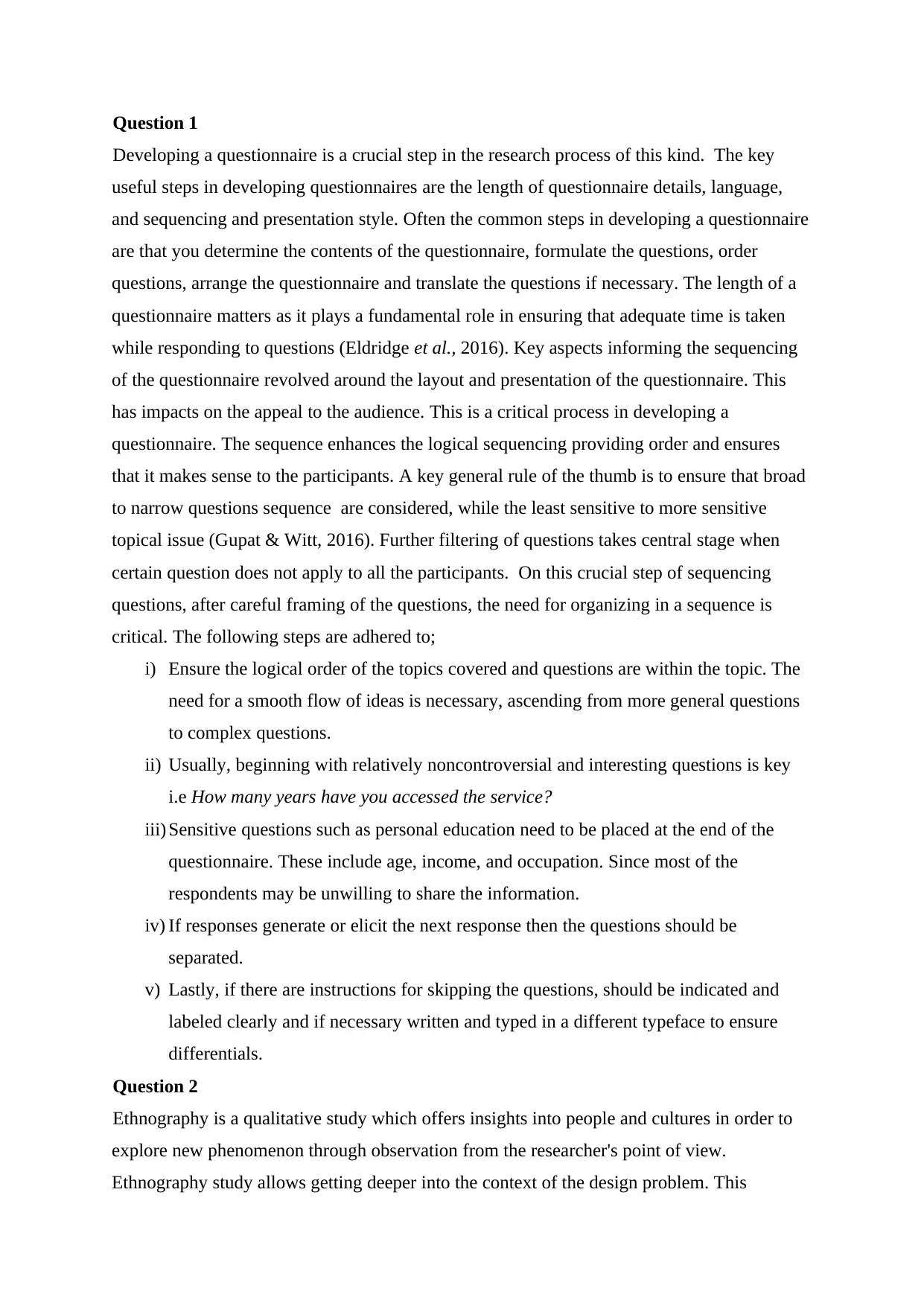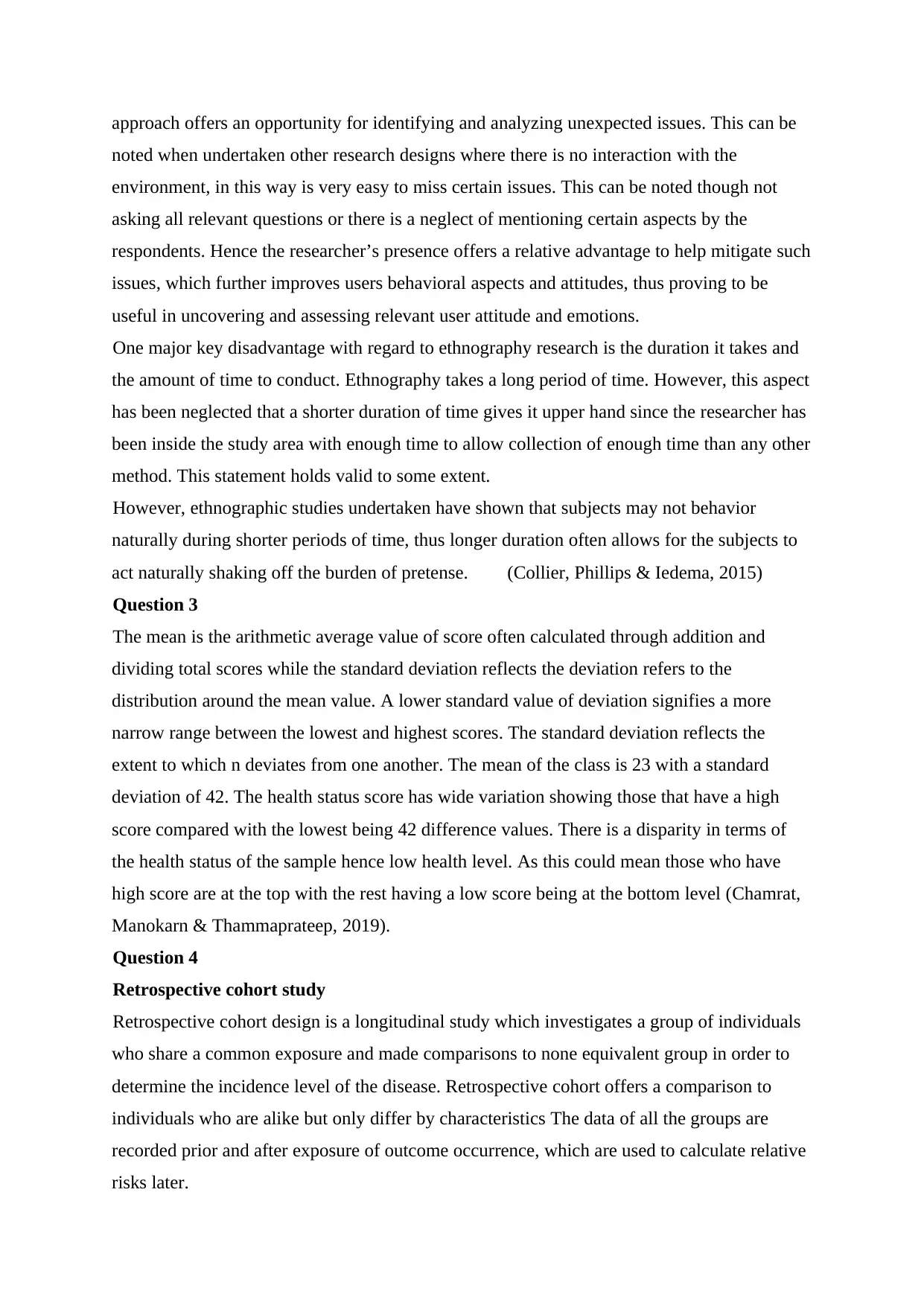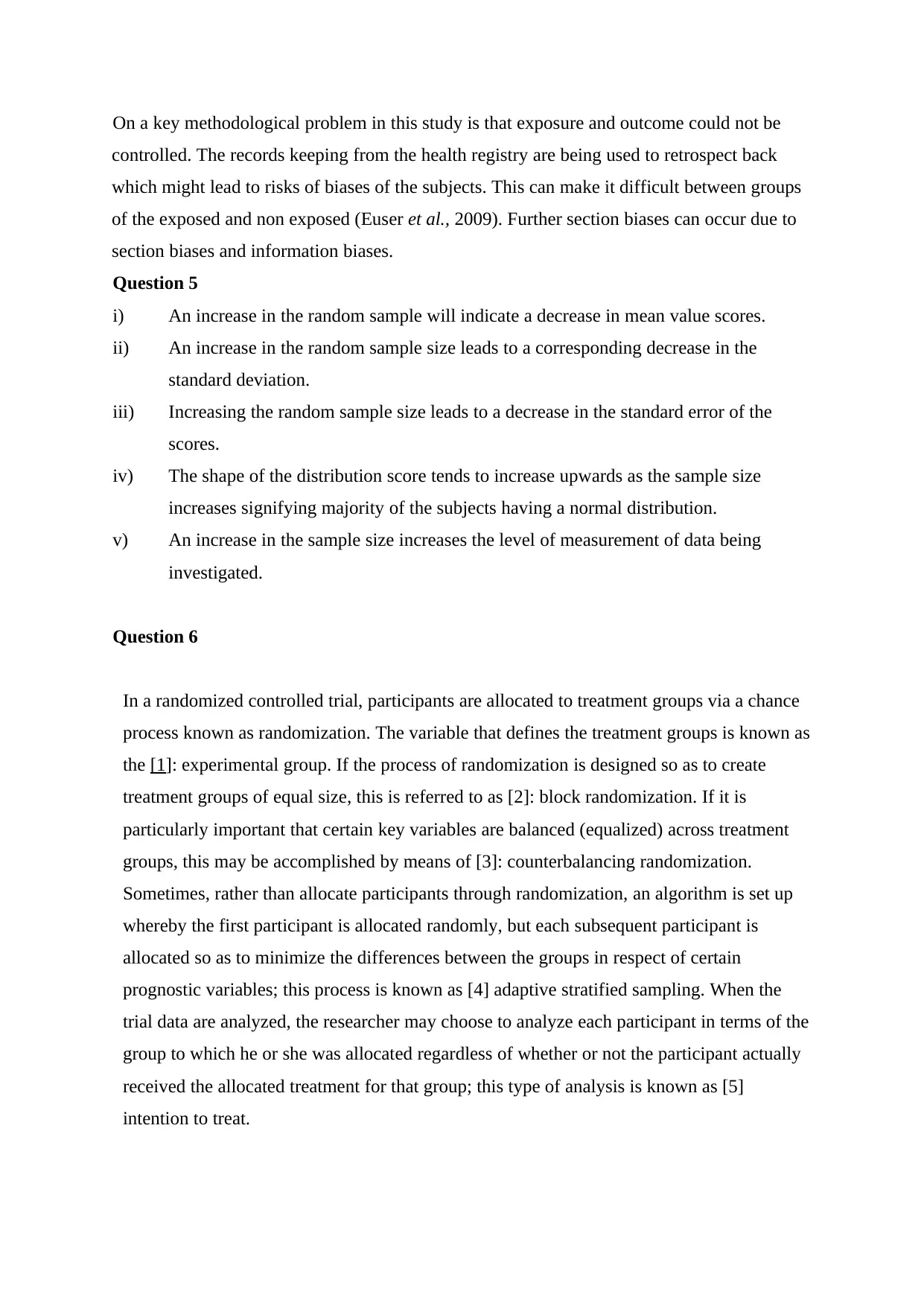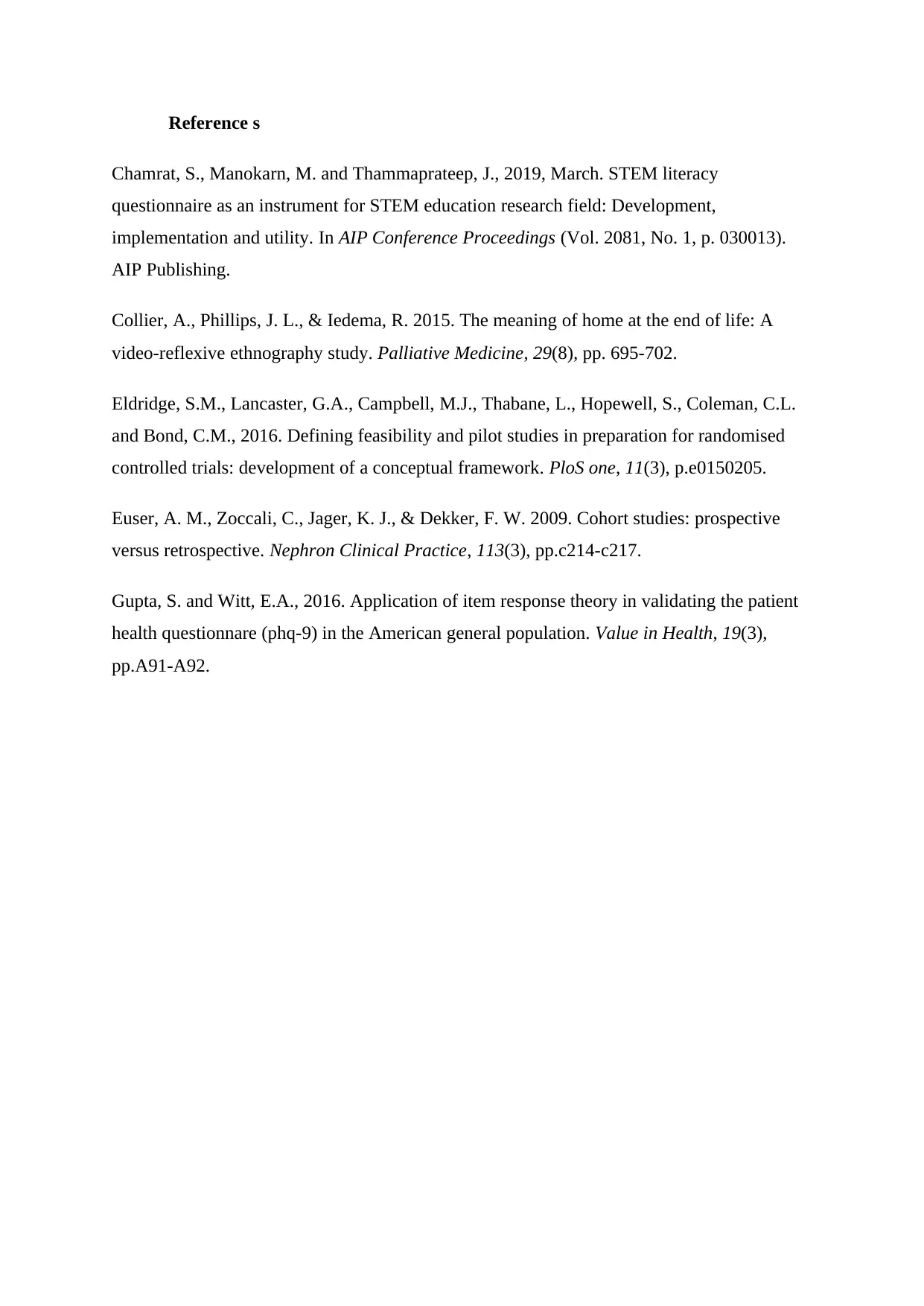Questionnaire Design, Ethnography and Randomized Controlled Trial
VerifiedAdded on 2023/04/11
|4
|1321
|90
Homework Assignment
AI Summary
This assignment delves into various aspects of healthcare research methodologies. It begins by discussing the crucial steps in developing effective questionnaires, emphasizing the importance of question length, language, sequencing, and presentation style. The assignment then explores the benefits and drawbacks of ethnographic research, highlighting its ability to uncover unexpected issues through in-depth observation. Further, it explains statistical concepts such as mean and standard deviation, interpreting their significance in health status scores. The assignment also examines retrospective cohort study designs, addressing potential methodological problems and biases. Additionally, it discusses the impact of increasing random sample sizes on mean value scores, standard deviation, and standard error. Finally, it explains key concepts in randomized controlled trials, including experimental groups, block randomization, counterbalancing randomization, adaptive stratified sampling, and intention-to-treat analysis.

Question 1
Developing a questionnaire is a crucial step in the research process of this kind. The key
useful steps in developing questionnaires are the length of questionnaire details, language,
and sequencing and presentation style. Often the common steps in developing a questionnaire
are that you determine the contents of the questionnaire, formulate the questions, order
questions, arrange the questionnaire and translate the questions if necessary. The length of a
questionnaire matters as it plays a fundamental role in ensuring that adequate time is taken
while responding to questions (Eldridge et al., 2016). Key aspects informing the sequencing
of the questionnaire revolved around the layout and presentation of the questionnaire. This
has impacts on the appeal to the audience. This is a critical process in developing a
questionnaire. The sequence enhances the logical sequencing providing order and ensures
that it makes sense to the participants. A key general rule of the thumb is to ensure that broad
to narrow questions sequence are considered, while the least sensitive to more sensitive
topical issue (Gupat & Witt, 2016). Further filtering of questions takes central stage when
certain question does not apply to all the participants. On this crucial step of sequencing
questions, after careful framing of the questions, the need for organizing in a sequence is
critical. The following steps are adhered to;
i) Ensure the logical order of the topics covered and questions are within the topic. The
need for a smooth flow of ideas is necessary, ascending from more general questions
to complex questions.
ii) Usually, beginning with relatively noncontroversial and interesting questions is key
i.e How many years have you accessed the service?
iii) Sensitive questions such as personal education need to be placed at the end of the
questionnaire. These include age, income, and occupation. Since most of the
respondents may be unwilling to share the information.
iv) If responses generate or elicit the next response then the questions should be
separated.
v) Lastly, if there are instructions for skipping the questions, should be indicated and
labeled clearly and if necessary written and typed in a different typeface to ensure
differentials.
Question 2
Ethnography is a qualitative study which offers insights into people and cultures in order to
explore new phenomenon through observation from the researcher's point of view.
Ethnography study allows getting deeper into the context of the design problem. This
Developing a questionnaire is a crucial step in the research process of this kind. The key
useful steps in developing questionnaires are the length of questionnaire details, language,
and sequencing and presentation style. Often the common steps in developing a questionnaire
are that you determine the contents of the questionnaire, formulate the questions, order
questions, arrange the questionnaire and translate the questions if necessary. The length of a
questionnaire matters as it plays a fundamental role in ensuring that adequate time is taken
while responding to questions (Eldridge et al., 2016). Key aspects informing the sequencing
of the questionnaire revolved around the layout and presentation of the questionnaire. This
has impacts on the appeal to the audience. This is a critical process in developing a
questionnaire. The sequence enhances the logical sequencing providing order and ensures
that it makes sense to the participants. A key general rule of the thumb is to ensure that broad
to narrow questions sequence are considered, while the least sensitive to more sensitive
topical issue (Gupat & Witt, 2016). Further filtering of questions takes central stage when
certain question does not apply to all the participants. On this crucial step of sequencing
questions, after careful framing of the questions, the need for organizing in a sequence is
critical. The following steps are adhered to;
i) Ensure the logical order of the topics covered and questions are within the topic. The
need for a smooth flow of ideas is necessary, ascending from more general questions
to complex questions.
ii) Usually, beginning with relatively noncontroversial and interesting questions is key
i.e How many years have you accessed the service?
iii) Sensitive questions such as personal education need to be placed at the end of the
questionnaire. These include age, income, and occupation. Since most of the
respondents may be unwilling to share the information.
iv) If responses generate or elicit the next response then the questions should be
separated.
v) Lastly, if there are instructions for skipping the questions, should be indicated and
labeled clearly and if necessary written and typed in a different typeface to ensure
differentials.
Question 2
Ethnography is a qualitative study which offers insights into people and cultures in order to
explore new phenomenon through observation from the researcher's point of view.
Ethnography study allows getting deeper into the context of the design problem. This
Paraphrase This Document
Need a fresh take? Get an instant paraphrase of this document with our AI Paraphraser

approach offers an opportunity for identifying and analyzing unexpected issues. This can be
noted when undertaken other research designs where there is no interaction with the
environment, in this way is very easy to miss certain issues. This can be noted though not
asking all relevant questions or there is a neglect of mentioning certain aspects by the
respondents. Hence the researcher’s presence offers a relative advantage to help mitigate such
issues, which further improves users behavioral aspects and attitudes, thus proving to be
useful in uncovering and assessing relevant user attitude and emotions.
One major key disadvantage with regard to ethnography research is the duration it takes and
the amount of time to conduct. Ethnography takes a long period of time. However, this aspect
has been neglected that a shorter duration of time gives it upper hand since the researcher has
been inside the study area with enough time to allow collection of enough time than any other
method. This statement holds valid to some extent.
However, ethnographic studies undertaken have shown that subjects may not behavior
naturally during shorter periods of time, thus longer duration often allows for the subjects to
act naturally shaking off the burden of pretense. (Collier, Phillips & Iedema, 2015)
Question 3
The mean is the arithmetic average value of score often calculated through addition and
dividing total scores while the standard deviation reflects the deviation refers to the
distribution around the mean value. A lower standard value of deviation signifies a more
narrow range between the lowest and highest scores. The standard deviation reflects the
extent to which n deviates from one another. The mean of the class is 23 with a standard
deviation of 42. The health status score has wide variation showing those that have a high
score compared with the lowest being 42 difference values. There is a disparity in terms of
the health status of the sample hence low health level. As this could mean those who have
high score are at the top with the rest having a low score being at the bottom level (Chamrat,
Manokarn & Thammaprateep, 2019).
Question 4
Retrospective cohort study
Retrospective cohort design is a longitudinal study which investigates a group of individuals
who share a common exposure and made comparisons to none equivalent group in order to
determine the incidence level of the disease. Retrospective cohort offers a comparison to
individuals who are alike but only differ by characteristics The data of all the groups are
recorded prior and after exposure of outcome occurrence, which are used to calculate relative
risks later.
noted when undertaken other research designs where there is no interaction with the
environment, in this way is very easy to miss certain issues. This can be noted though not
asking all relevant questions or there is a neglect of mentioning certain aspects by the
respondents. Hence the researcher’s presence offers a relative advantage to help mitigate such
issues, which further improves users behavioral aspects and attitudes, thus proving to be
useful in uncovering and assessing relevant user attitude and emotions.
One major key disadvantage with regard to ethnography research is the duration it takes and
the amount of time to conduct. Ethnography takes a long period of time. However, this aspect
has been neglected that a shorter duration of time gives it upper hand since the researcher has
been inside the study area with enough time to allow collection of enough time than any other
method. This statement holds valid to some extent.
However, ethnographic studies undertaken have shown that subjects may not behavior
naturally during shorter periods of time, thus longer duration often allows for the subjects to
act naturally shaking off the burden of pretense. (Collier, Phillips & Iedema, 2015)
Question 3
The mean is the arithmetic average value of score often calculated through addition and
dividing total scores while the standard deviation reflects the deviation refers to the
distribution around the mean value. A lower standard value of deviation signifies a more
narrow range between the lowest and highest scores. The standard deviation reflects the
extent to which n deviates from one another. The mean of the class is 23 with a standard
deviation of 42. The health status score has wide variation showing those that have a high
score compared with the lowest being 42 difference values. There is a disparity in terms of
the health status of the sample hence low health level. As this could mean those who have
high score are at the top with the rest having a low score being at the bottom level (Chamrat,
Manokarn & Thammaprateep, 2019).
Question 4
Retrospective cohort study
Retrospective cohort design is a longitudinal study which investigates a group of individuals
who share a common exposure and made comparisons to none equivalent group in order to
determine the incidence level of the disease. Retrospective cohort offers a comparison to
individuals who are alike but only differ by characteristics The data of all the groups are
recorded prior and after exposure of outcome occurrence, which are used to calculate relative
risks later.

On a key methodological problem in this study is that exposure and outcome could not be
controlled. The records keeping from the health registry are being used to retrospect back
which might lead to risks of biases of the subjects. This can make it difficult between groups
of the exposed and non exposed (Euser et al., 2009). Further section biases can occur due to
section biases and information biases.
Question 5
i) An increase in the random sample will indicate a decrease in mean value scores.
ii) An increase in the random sample size leads to a corresponding decrease in the
standard deviation.
iii) Increasing the random sample size leads to a decrease in the standard error of the
scores.
iv) The shape of the distribution score tends to increase upwards as the sample size
increases signifying majority of the subjects having a normal distribution.
v) An increase in the sample size increases the level of measurement of data being
investigated.
Question 6
In a randomized controlled trial, participants are allocated to treatment groups via a chance
process known as randomization. The variable that defines the treatment groups is known as
the [1]: experimental group. If the process of randomization is designed so as to create
treatment groups of equal size, this is referred to as [2]: block randomization. If it is
particularly important that certain key variables are balanced (equalized) across treatment
groups, this may be accomplished by means of [3]: counterbalancing randomization.
Sometimes, rather than allocate participants through randomization, an algorithm is set up
whereby the first participant is allocated randomly, but each subsequent participant is
allocated so as to minimize the differences between the groups in respect of certain
prognostic variables; this process is known as [4] adaptive stratified sampling. When the
trial data are analyzed, the researcher may choose to analyze each participant in terms of the
group to which he or she was allocated regardless of whether or not the participant actually
received the allocated treatment for that group; this type of analysis is known as [5]
intention to treat.
controlled. The records keeping from the health registry are being used to retrospect back
which might lead to risks of biases of the subjects. This can make it difficult between groups
of the exposed and non exposed (Euser et al., 2009). Further section biases can occur due to
section biases and information biases.
Question 5
i) An increase in the random sample will indicate a decrease in mean value scores.
ii) An increase in the random sample size leads to a corresponding decrease in the
standard deviation.
iii) Increasing the random sample size leads to a decrease in the standard error of the
scores.
iv) The shape of the distribution score tends to increase upwards as the sample size
increases signifying majority of the subjects having a normal distribution.
v) An increase in the sample size increases the level of measurement of data being
investigated.
Question 6
In a randomized controlled trial, participants are allocated to treatment groups via a chance
process known as randomization. The variable that defines the treatment groups is known as
the [1]: experimental group. If the process of randomization is designed so as to create
treatment groups of equal size, this is referred to as [2]: block randomization. If it is
particularly important that certain key variables are balanced (equalized) across treatment
groups, this may be accomplished by means of [3]: counterbalancing randomization.
Sometimes, rather than allocate participants through randomization, an algorithm is set up
whereby the first participant is allocated randomly, but each subsequent participant is
allocated so as to minimize the differences between the groups in respect of certain
prognostic variables; this process is known as [4] adaptive stratified sampling. When the
trial data are analyzed, the researcher may choose to analyze each participant in terms of the
group to which he or she was allocated regardless of whether or not the participant actually
received the allocated treatment for that group; this type of analysis is known as [5]
intention to treat.
⊘ This is a preview!⊘
Do you want full access?
Subscribe today to unlock all pages.

Trusted by 1+ million students worldwide

Reference s
Chamrat, S., Manokarn, M. and Thammaprateep, J., 2019, March. STEM literacy
questionnaire as an instrument for STEM education research field: Development,
implementation and utility. In AIP Conference Proceedings (Vol. 2081, No. 1, p. 030013).
AIP Publishing.
Collier, A., Phillips, J. L., & Iedema, R. 2015. The meaning of home at the end of life: A
video-reflexive ethnography study. Palliative Medicine, 29(8), pp. 695-702.
Eldridge, S.M., Lancaster, G.A., Campbell, M.J., Thabane, L., Hopewell, S., Coleman, C.L.
and Bond, C.M., 2016. Defining feasibility and pilot studies in preparation for randomised
controlled trials: development of a conceptual framework. PloS one, 11(3), p.e0150205.
Euser, A. M., Zoccali, C., Jager, K. J., & Dekker, F. W. 2009. Cohort studies: prospective
versus retrospective. Nephron Clinical Practice, 113(3), pp.c214-c217.
Gupta, S. and Witt, E.A., 2016. Application of item response theory in validating the patient
health questionnare (phq-9) in the American general population. Value in Health, 19(3),
pp.A91-A92.
Chamrat, S., Manokarn, M. and Thammaprateep, J., 2019, March. STEM literacy
questionnaire as an instrument for STEM education research field: Development,
implementation and utility. In AIP Conference Proceedings (Vol. 2081, No. 1, p. 030013).
AIP Publishing.
Collier, A., Phillips, J. L., & Iedema, R. 2015. The meaning of home at the end of life: A
video-reflexive ethnography study. Palliative Medicine, 29(8), pp. 695-702.
Eldridge, S.M., Lancaster, G.A., Campbell, M.J., Thabane, L., Hopewell, S., Coleman, C.L.
and Bond, C.M., 2016. Defining feasibility and pilot studies in preparation for randomised
controlled trials: development of a conceptual framework. PloS one, 11(3), p.e0150205.
Euser, A. M., Zoccali, C., Jager, K. J., & Dekker, F. W. 2009. Cohort studies: prospective
versus retrospective. Nephron Clinical Practice, 113(3), pp.c214-c217.
Gupta, S. and Witt, E.A., 2016. Application of item response theory in validating the patient
health questionnare (phq-9) in the American general population. Value in Health, 19(3),
pp.A91-A92.
1 out of 4
Related Documents
Your All-in-One AI-Powered Toolkit for Academic Success.
+13062052269
info@desklib.com
Available 24*7 on WhatsApp / Email
![[object Object]](/_next/static/media/star-bottom.7253800d.svg)
Unlock your academic potential
Copyright © 2020–2025 A2Z Services. All Rights Reserved. Developed and managed by ZUCOL.





